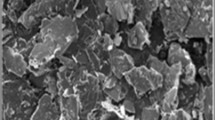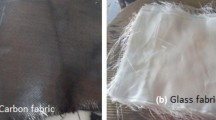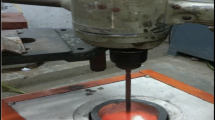Abstract
In this work, pure aluminium and NiTi is used as matrix and reinforcement to fabricate a smart composite. To get an improved mechanical property, primarily the powder metallurgy process parameters are optimized, and the best processing parameters are used for the fabrication of composites materials and subsequently the composite is used for machining studies. Abrasive Water Jet Machining (AWJM) process is used to study the machinability characteristics of the Al- NiTi smart composites. To study the effect of AWJM parameters on Al-NiTi composites, the following control variables identified are Transverse Speed (TS), Applied Pressure (AP), Standoff Distance (SoD), % Wt. of reinforcements (wt%), Abrasive Size (AS). The output indices are Surface Roughness (Ra) and Kerf Angle (Ka). The experiments are designed and conducted based on the design of experiment. Further, it describes the effectiveness of the hybrid algorithm in predicting and optimizing the Abrasive Water Jet Machining (AWJM) parameters. Grey Relational Analysis (GRA) is used as a feature selection and optimizing tool. The result of feature selection by GRA–Entropy, reveals that the most influencing control variables are ranked in the order as AS, AP, TS, wt% and SoD. Modelling of AWJM process is done by Support Vector Machine algorithm (SVM), and the performance of the model is compared with SVM hybrid models. A hybrid model is developed with the concept of Differential Evolutionary algorithm (DE) and Entropy. Hybrid SVM–Entropy model displayed increased prediction performance by 37.8% compared to the SVM model. GRA–SVM–Entropy hybrid model is compared with the SVM model, it is found that the prediction performance of the GRA–SVM–Entropy hybrid model increased by 49.1%. It is found from the GRA–Entropy method; the optimal conditions are A2, B1, C1, D3, and E1.
Access this chapter
Tax calculation will be finalised at checkout
Purchases are for personal use only
Similar content being viewed by others
References
S.R. Bakshi, D. Lahiri, A. Agarwal, Carbon nanotube reinforced metal matrix composites—a review. Int. Mater. Rev. 55(1), 41–64 (2010)
D.B. Miracle, Metal matrix composites—from science to technological significance. Compos. Sci. Technol. 65(15–16), 2526–2540 (2005)
G.A. Porter, P.K. Liaw, T.N. Tiegs, K.H. Wu, Fatigue and fracture behavior of nickel-titanium shape-memory alloy reinforced aluminum composites. Mater. Sci. Eng., A 314(1–2), 186–193 (2001)
S.L. Angioni, M. Meo, A. Foreman, Impact damage resistance and damage suppression properties of shape memory alloys in hybrid composites—a review. Smart Mater Struct. 20(1) (2011)
M. Dixit, J.W. Newkirk, R.S. Mishra, Properties of friction stir processes Al 1100-NiTi composite. Scr. Mater. 56, 541–544 (2007)
C.L. **e, M. Hailat, X. Wu, G.M. Newaz, M. Taya, B. Raju, Development of short fiber reinforced NiTi/Al6061composites. ASME J. Eng. Mater. Technol. 129, 69–76 (2007)
D. San Martín, D.D. Risanti, G. Garces, P.E.J. Rivera Diaz del Castillo, S. van der Zwaag, On the production and properties of novel particulate NiTip/AA2124 metal matrix composites. Mater. Sci. Eng., A 526, 250–252 (2009)
O. Akalin, K.V. Ezirmik, M. Urgen, G.M. Newaz, Wear characteristics of NiTi/Al6061 short fiber metal matrix composite reinforced with SiC particulates. J. Tribol. 132(4) (2010)
H.C. Lin, K.M. Lin, Y.C. Chen, A study on the machining characteristics of TiNi shape memory alloys. J. Mater. Process. Technol. 105, 327–332 (2000)
S. Narendranath, M. Manjaiah, S. Basavarajappa, V.N. Gaitonde, Experimental investigations on performance characteristics in wire electro discharge machining of Ti50Ni42.4Cu7.6 shape memory alloy. Proc. Inst. Mech. Eng. B J. Eng. Manuf. 227(8), 1180–1187 (2013)
H. Abdizadeh, M. Ashuri, P.T. Moghadam, A. Nouribahadory, H.R. Baharvandi, Improvement in physical and mechanical properties of aluminum/zircon composites fabricated by powder metallurgy method. Mater. Des. 32(8), 4417–4423 (2011)
T.C. Phokane, K. Gupta, M.K. Gupta, Investigations on surface roughness and tribology of miniature brass gears manufactured by abrasive water jet machining. Proc. IMechE, Part C: J. Mech. Eng. Sci. (Sage) 232(22), 4193–4202 (2018)
M.C. Kong, D. Axinte, W. Voice, Challenges in using waterjet machining of NiTi shape memory alloys: an analysis of controlled depth milling. J. Mater. Process. Technol. 211(6), 959–971 (2011)
M. Frotscher, F. Kahleyss, T. Simon, D. Biermann, G. Eggeler, Achieving small structures in thin NiTi sheets for medical applications with water jet and micro machining: a comparison. J. Mater. Eng. Perform. 15, 776–782 (2011)
J. Zhou, J. Ren, C. Yao, Multi-objective optimization of multi-axis ball-end milling Inconel 718 via grey relational analysis coupled with RBF neural network and PSO algorithm. Measurement 102, 271–285 (2017)
H.S. Lu, C.K. Chang, N.C. Hwang, C.T. Chung, Grey relational analysis coupled with principal component analysis for optimization design of the cutting parameters in high-speed end milling. J. Mater. Process. Technol. 209(8), 3808–3817 (2009)
A. Nair, S. Kumanan, Multi-performance optimization of abrasive water jet machining of Inconel 617 using WPCA. Mater. Manuf. Processes 32(6), 693–699 (2017)
S. Rajesh, S. Rajakarunakaran, R. Sudhkarapandian, Optimization of the red mud–aluminum composite in the turning process by the Grey relational analysis with entropy. J. Compos. Mater. 48(17), 2097–2105 (2014)
A.M. Zain, H. Haron, S. Sharif, Estimation of the minimum machining performance in the abrasive waterjet machining using integrated ANN-SA. Expert Syst. Appl. 38(7), 8316–8326 (2011)
T. Verplancke, S. Van Looy, D. Benoit, S. Vansteelandt, P. Depuydt, F. De Turck, J. Decruyenaere, Support vector machine versus logistic regression modeling for prediction of hospital mortality in critically ill patients with haematological malignancies. BMC Med. Inform. Decis. Mak. 8(56), 1–8 (2008)
R. Venkata Rao, V.D. Kalyankar, Optimization of modern machining processes using advanced optimization techniques: a review. Int. J. Adv. Manuf. Technol. 73(5–8), 1159–1188 (2014)
Ulaş Çaydaş, Sami Ekici, Support vector machines models for Ra prediction in CNC turning of AISI 304 austenitic stainless steel. J. Intell. Manuf. 23(3), 639–650 (2012)
Author information
Authors and Affiliations
Corresponding author
Editor information
Editors and Affiliations
Rights and permissions
Copyright information
© 2021 Springer Nature Switzerland AG
About this chapter
Cite this chapter
Rajesh, S., Nair, A., Adam Khan, M., Ra**i, N. (2021). Hybrid Approach for Prediction and Modelling of Abrasive Water Jet Machining Parameter on Al-NiTi Composites. In: Pathak, S. (eds) Intelligent Manufacturing. Materials Forming, Machining and Tribology. Springer, Cham. https://doi.org/10.1007/978-3-030-50312-3_8
Download citation
DOI: https://doi.org/10.1007/978-3-030-50312-3_8
Published:
Publisher Name: Springer, Cham
Print ISBN: 978-3-030-50311-6
Online ISBN: 978-3-030-50312-3
eBook Packages: EngineeringEngineering (R0)




